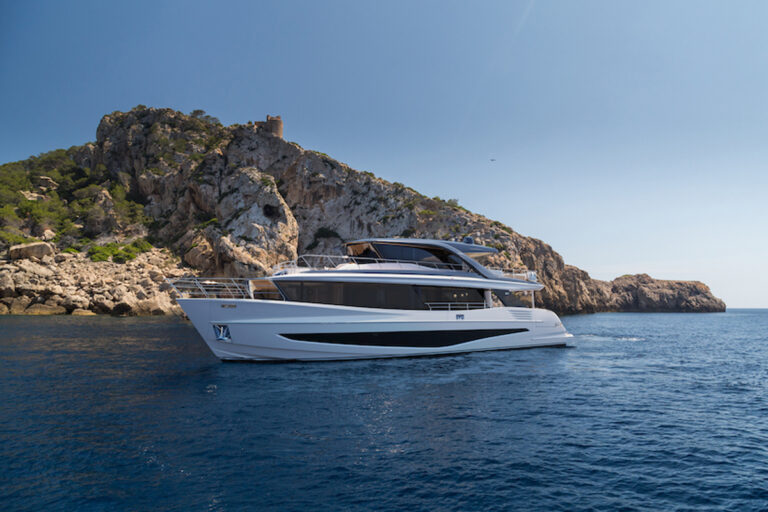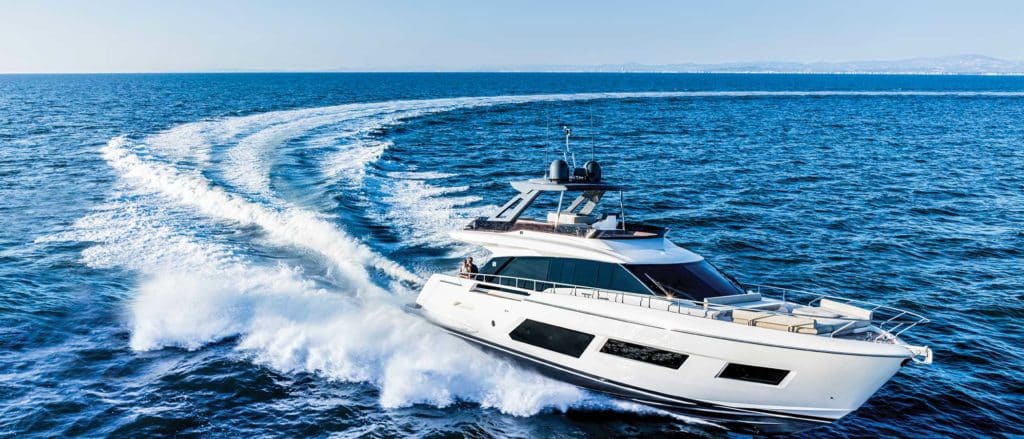
The Ferretti Yachts 670 is an important model. Not only is it the last of the Italian builder’s range renewals, but it’s also the first to be designed by Filippo Salvetti.
We’re not talking revolution at this stage, he says. The yacht is more of an evolution. Cues to Ferretti’s past and future are evident.
Externally, the hull sides and windows have cleaner, sharper edges than we’re used to seeing on Ferretti builds. Internally, the spaces are more generous, and there is an even richer feeling than usual, moving Ferretti ever deeper into the luxury zone.
As for performance, she is pure Ferretti. I got aboard Hull No. 1 straight out of the box for her first sea trial at the Cannes Yachting Festival. She’s offered with twin 1,000 hp or 1,200 hp MAN V-8s spinning in and out of ZF V-boxes; owners will need to decide whether they’re happy with a maximum speed north or south of 30 knots. I’m told that the majority of owners are bound to opt for the more powerful blocks; of the first 10 hulls being built, only a couple are scheduled to get the less-thirsty option.
More power is worthwhile on this build. The 670 displaces 87,083 pounds (light), which is about 4,400 pounds heavier than the Ferretti 650 that this model replaces. The new model is also 7 inches wider.
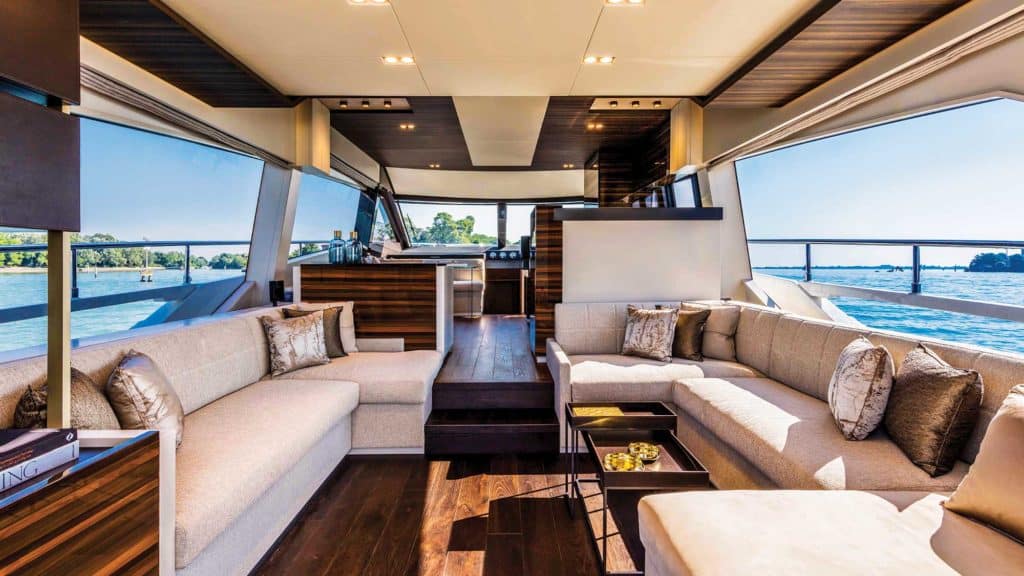
With the bigger MANs, Hull No. 1 topped out at just over 33 knots. And she was reasonably heavy at the time, full of fuel and a third full of water with two gyrostabilizers and eight people aboard — but no tender on the high-low platform. She’ll accommodate a Williams 345 or, if the passerelle is eliminated, a Williams 395. A continuous 2,000 rpm cruise translates to around 27 knots and a range of 290 nautical miles without a fuel reserve. I preferred a laid-back 10 knots with those 1,200s rumbling under 1,000 rpm, which meant burning roughly 6.5 gallons of diesel per hour, making her range more than 750 nautical miles with a 10 percent reserve.
Ferretti’s in-house team not only elevated performance with the 670, but also gave her “active” electro-hydraulic steering. Her rudders move independently and will keep a course without using the autopilot. The steering wheels self-center too. Working in concert with the Xenta joystick, the shafts and Quick bow thruster not only aid with docking, but also provide dynamic-positioning capability. In cruise mode, to a maximum speed of about 28 knots, the joystick delivers throttle and steering. The system couldn’t be simpler for skippers.
Both the lower and upper helm stations are ergonomically designed. The lower helm, which is offset to starboard with a side-deck door, has three Naviop-Simrad integrated screens that can call up the three principal categories of information: house, propulsion and navigation. The flybridge helm has two displays.
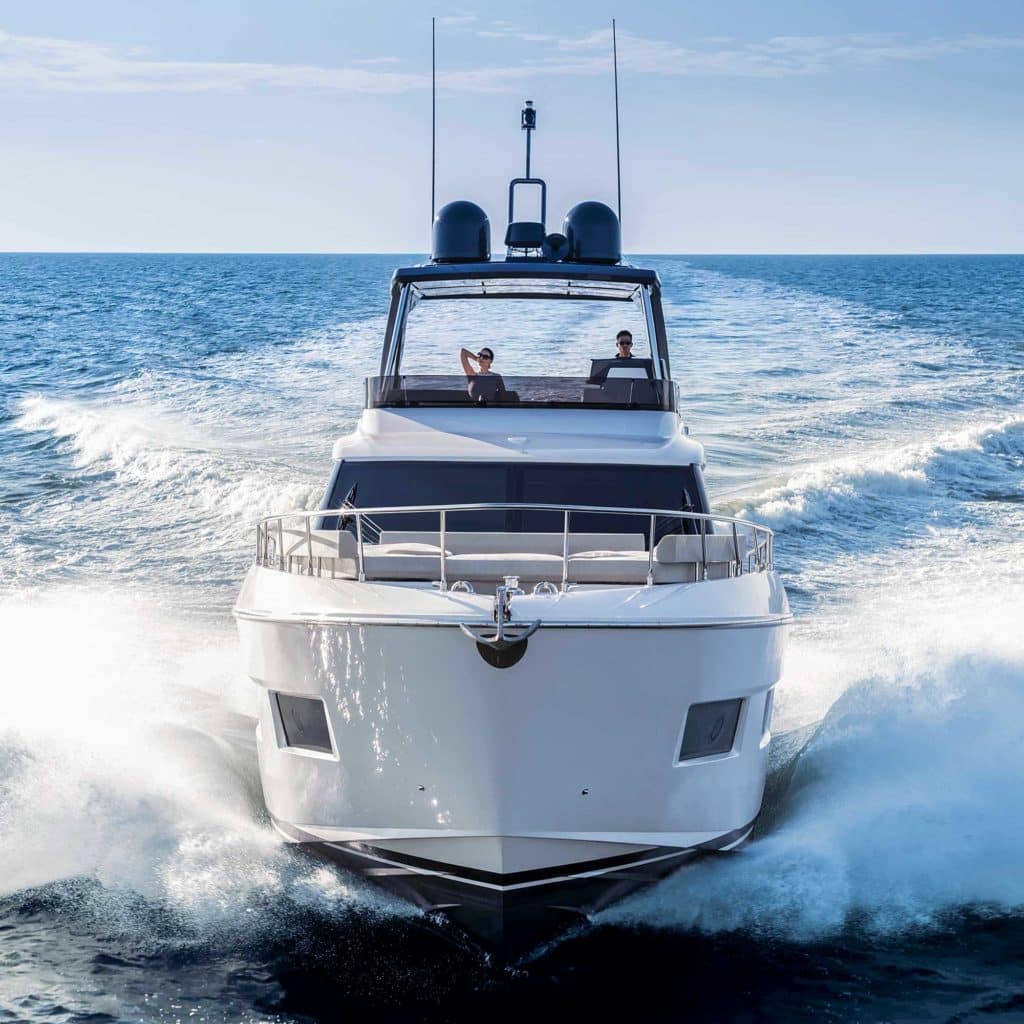
In terms of guest comfort, Salvetti also elevated the 670’s exterior spaces. There’s an almost 260-square-foot flybridge, a half-size hardtop, and an aft deck with a sofa and tender lift. On the foredeck, there’s far more than a standard sun pad: He added multiple sofas, a four-post sunshade, and sun pads that convert to tables. The sofa backrests stand proudly at the base of the windscreen and extend along each side, virtually to rail height. These amenities are visible as part of the yacht’s exterior view, but the gain in creature comforts more than offsets any aesthetic compromise.
Inside, Salvetti conceived the 670’s general arrangement, with the Ferretti in-house team handling décor. The main deck is split-level, with the salon down and aft, and the dinette and galley up and forward. The windows are wide with minimal obstructions, and the incoming light bounces everywhere.
The décor is more dramatic than aboard Ferrettis of recent years. In particular, the high-gloss walnut veneers crave attention. They are actually composite sheets made from strips of different walnuts with various stains. The result is like a tigerwood on steroids, interspersed with muted mattes, off-whites, a silk-burnished oak sole and chocolatey leathers.
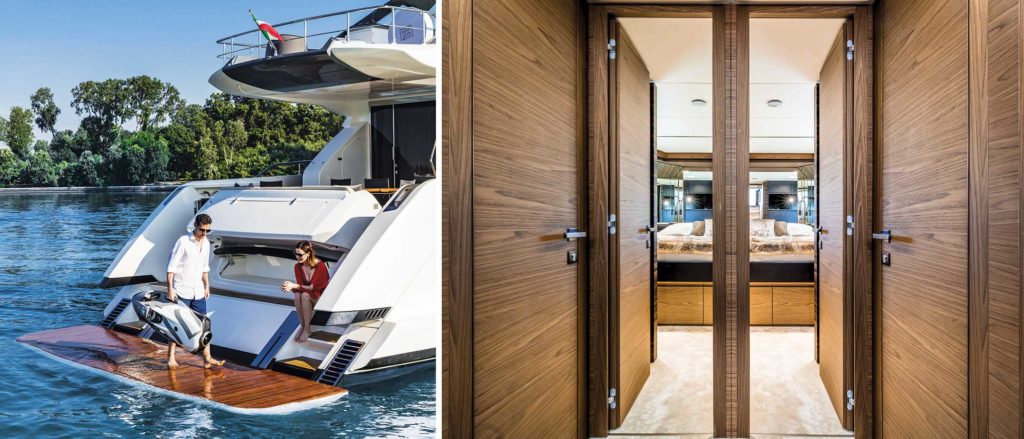
The first 670 had the standard three-stateroom layout, but Hull No. 3, which was shown at the Fort Lauderdale International Boat Show in November, had the optional four staterooms (the fourth is without an en suite head). The trade-off for the extra twin-berth stateroom is a study in the owners’ full-beam stateroom, which occupies around 195 square feet. That stateroom also has an en suite head, walk-in closet and hullside windows.
The whole owners’ space sits lower in the hull than the rest of the guest accommodations, which means the desk and bookshelves are on a different level with a couple of steps down to the sleeping space. This split-level configuration helps with headroom; I sat there while taking notes, soaking up the views and dreaming of just how splendid the experience would be if it really were my office. But if you have family and friends, and are sensible enough not to work while aboard, maybe sacrificing the study for two more berths is well worth it.
Headroom throughout the lower deck is between 6 feet 6 inches and 7 feet 7 inches, with 7 feet 8-plus inches in the main salon. The heights add to the yacht’s sense of smart proportions, making the Ferretti 670 well worth a look — and all of us eager to see where the builder and Salvetti plan to take things next.

Designer Filippo Salvetti
Bergamo, Italy-based Filippo Salvetti has signed an exclusive agreement with the Ferretti Group. From here on, the 46-year-old yacht designer is responsible for all exteriors and interior layouts in the Ferretti Yachts portfolio.
He studied architecture with industrial design at the Politecnico di Milano, the oldest and most revered university in a city that is the de facto style capital of the world. Completing the circle, Salvetti also lectures with his old faculty part-time, a fact that is even more impressive given that the school usually ranks among the world’s top 10 for architecture.
His big break in yacht design came in 2002, when he joined Mauro Micheli’s Officina Italiana Design studio, which has been the brains behind Riva’s styling for almost 25 years as a Ferretti Group design partner. Next, Salvetti established Neo Design with Marco Biaggi. They worked with Azimut-Benetti from 2009 until recently, developing more than a half-dozen of the most recent Atlantis models and some Benetti concept yachts. Salvetti also has designed planing models from 70 to 120 feet length overall for the Italian yard Bugari.
Salvetti’s design debut for the Ferretti Group is the Ferretti 670, which he began working on in late 2016. The new-for-2019 Ferretti 720 is expected to push his evolutionary design ideas further still.
Made in Italy
The Ferretti 670 is built at the Ferretti Group’s facility in Forli, Italy, about 20 miles inland of the Adriatic coast, southeast of Bologna. Ferretti also builds its 450, 550, 700 and coming-soon 720 here, as well as the Itama 45 and 62. Bigger Ferrettis — the 780, 850, 920 and 960 — are built at a plant in Cattolica, 45 miles southeast of Forli and on the Adriatic.








